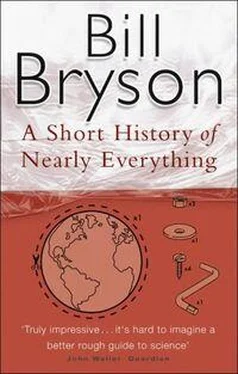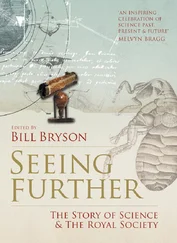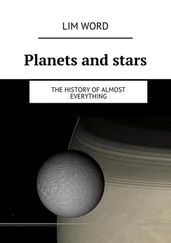I should say that everything is just right so far . In the long term, gravity may turn out to be a little too strong, and one day it may halt the expansion of the universe and bring it collapsing in upon itself, till it crushes itself down into another singularity, possibly to start the whole process over again. On the other hand it may be too weak and the universe will keep racing away forever until everything is so far apart that there is no chance of material interactions, so that the universe becomes a place that is inert and dead, but very roomy. The third option is that gravity is just right-“critical density” is the cosmologists’ term for it-and that it will hold the universe together at just the right dimensions to allow things to go on indefinitely. Cosmologists in their lighter moments sometimes call this the Goldilocks effect-that everything is just right. (For the record, these three possible universes are known respectively as closed, open, and flat.)
Now the question that has occurred to all of us at some point is: what would happen if you traveled out to the edge of the universe and, as it were, put your head through the curtains? Where would your head be if it were no longer in the universe? What would you find beyond? The answer, disappointingly, is that you can never get to the edge of the universe. That’s not because it would take too long to get there-though of course it would-but because even if you traveled outward and outward in a straight line, indefinitely and pugnaciously, you would never arrive at an outer boundary. Instead, you would come back to where you began (at which point, presumably, you would rather lose heart in the exercise and give up). The reason for this is that the universe bends, in a way we can’t adequately imagine, in conformance with Einstein’s theory of relativity (which we will get to in due course). For the moment it is enough to know that we are not adrift in some large, ever-expanding bubble. Rather, space curves, in a way that allows it to be boundless but finite. Space cannot even properly be said to be expanding because, as the physicist and Nobel laureate Steven Weinberg notes, “solar systems and galaxies are not expanding, and space itself is not expanding.” Rather, the galaxies are rushing apart. It is all something of a challenge to intuition. Or as the biologist J. B. S. Haldane once famously observed: “The universe is not only queerer than we suppose; it is queerer than we can suppose.”
The analogy that is usually given for explaining the curvature of space is to try to imagine someone from a universe of flat surfaces, who had never seen a sphere, being brought to Earth. No matter how far he roamed across the planet’s surface, he would never find an edge. He might eventually return to the spot where he had started, and would of course be utterly confounded to explain how that had happened. Well, we are in the same position in space as our puzzled flatlander, only we are flummoxed by a higher dimension.
Just as there is no place where you can find the edge of the universe, so there is no place where you can stand at the center and say: “This is where it all began. This is the centermost point of it all.” We are all at the center of it all. Actually, we don’t know that for sure; we can’t prove it mathematically. Scientists just assume that we can’t really be the center of the universe-think what that would imply-but that the phenomenon must be the same for all observers in all places. Still, we don’t actually know.
For us, the universe goes only as far as light has traveled in the billions of years since the universe was formed. This visible universe-the universe we know and can talk about-is a million million million million (that’s 1,000,000,000,000,000,000,000,000) miles across. But according to most theories the universe at large-the meta-universe, as it is sometimes called-is vastly roomier still. According to Rees, the number of light-years to the edge of this larger, unseen universe would be written not “with ten zeroes, not even with a hundred, but with millions.” In short, there’s more space than you can imagine already without going to the trouble of trying to envision some additional beyond.
For a long time the Big Bang theory had one gaping hole that troubled a lot of people-namely that it couldn’t begin to explain how we got here. Although 98 percent of all the matter that exists was created with the Big Bang, that matter consisted exclusively of light gases: the helium, hydrogen, and lithium that we mentioned earlier. Not one particle of the heavy stuff so vital to our own being-carbon, nitrogen, oxygen, and all the rest-emerged from the gaseous brew of creation. But-and here’s the troubling point-to forge these heavy elements, you need the kind of heat and energy of a Big Bang. Yet there has been only one Big Bang and it didn’t produce them. So where did they come from?
Interestingly, the man who found the answer to that question was a cosmologist who heartily despised the Big Bang as a theory and coined the term “Big Bang” sarcastically, as a way of mocking it. We’ll get to him shortly, but before we turn to the question of how we got here, it might be worth taking a few minutes to consider just where exactly “here” is.
2 WELCOME TO THE SOLAR SYSTEM
ASTRONOMERS THESE DAYS can do the most amazing things. If someone struck a match on the Moon, they could spot the flare. From the tiniest throbs and wobbles of distant stars they can infer the size and character and even potential habitability of planets much too remote to be seen-planets so distant that it would take us half a million years in a spaceship to get there. With their radio telescopes they can capture wisps of radiation so preposterously faint that the total amount of energy collected from outside the solar system by all of them together since collecting began (in 1951) is “less than the energy of a single snowflake striking the ground,” in the words of Carl Sagan.
In short, there isn’t a great deal that goes on in the universe that astronomers can’t find when they have a mind to. Which is why it is all the more remarkable to reflect that until 1978 no one had ever noticed that Pluto has a moon. In the summer of that year, a young astronomer named James Christy at the U.S. Naval Observatory in Flagstaff, Arizona, was making a routine examination of photographic images of Pluto when he saw that there was something there-something blurry and uncertain but definitely other than Pluto. Consulting a colleague named Robert Harrington, he concluded that what he was looking at was a moon. And it wasn’t just any moon. Relative to the planet, it was the biggest moon in the solar system.
This was actually something of a blow to Pluto’s status as a planet, which had never been terribly robust anyway. Since previously the space occupied by the moon and the space occupied by Pluto were thought to be one and the same, it meant that Pluto was much smaller than anyone had supposed-smaller even than Mercury. Indeed, seven moons in the solar system, including our own, are larger.
Now a natural question is why it took so long for anyone to find a moon in our own solar system. The answer is that it is partly a matter of where astronomers point their instruments and partly a matter of what their instruments are designed to detect, and partly it’s just Pluto. Mostly it’s where they point their instruments. In the words of the astronomer Clark Chapman: “Most people think that astronomers get out at night in observatories and scan the skies. That’s not true. Almost all the telescopes we have in the world are designed to peer at very tiny little pieces of the sky way off in the distance to see a quasar or hunt for black holes or look at a distant galaxy. The only real network of telescopes that scans the skies has been designed and built by the military.”
Читать дальше












